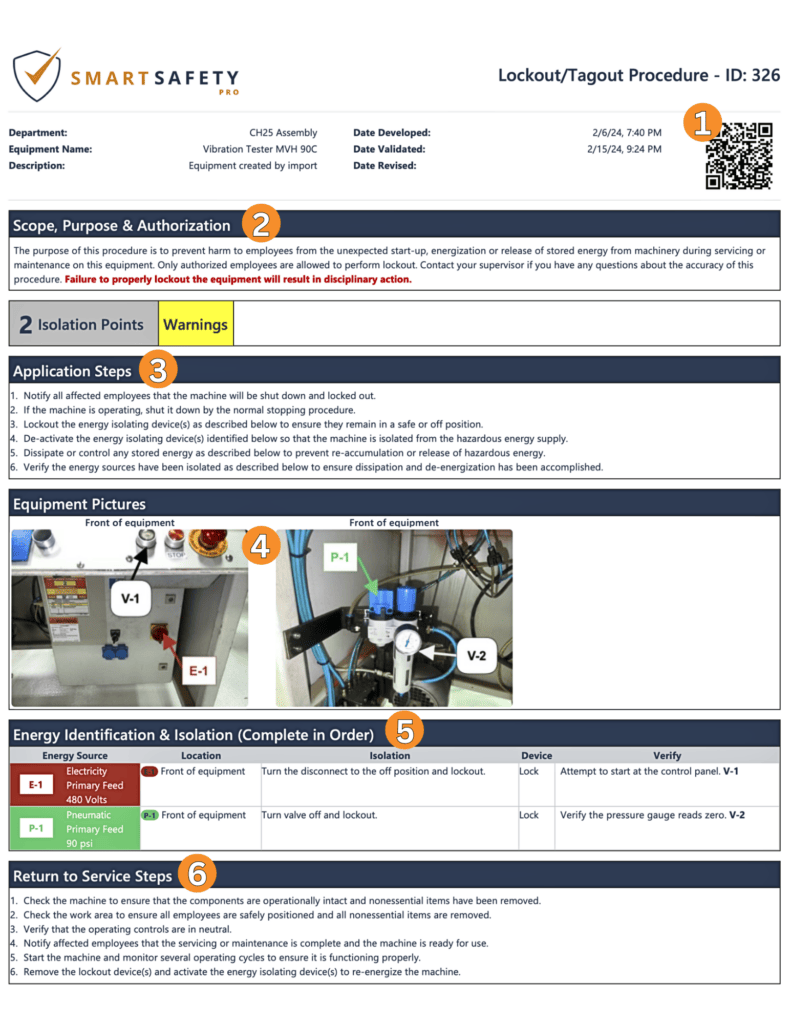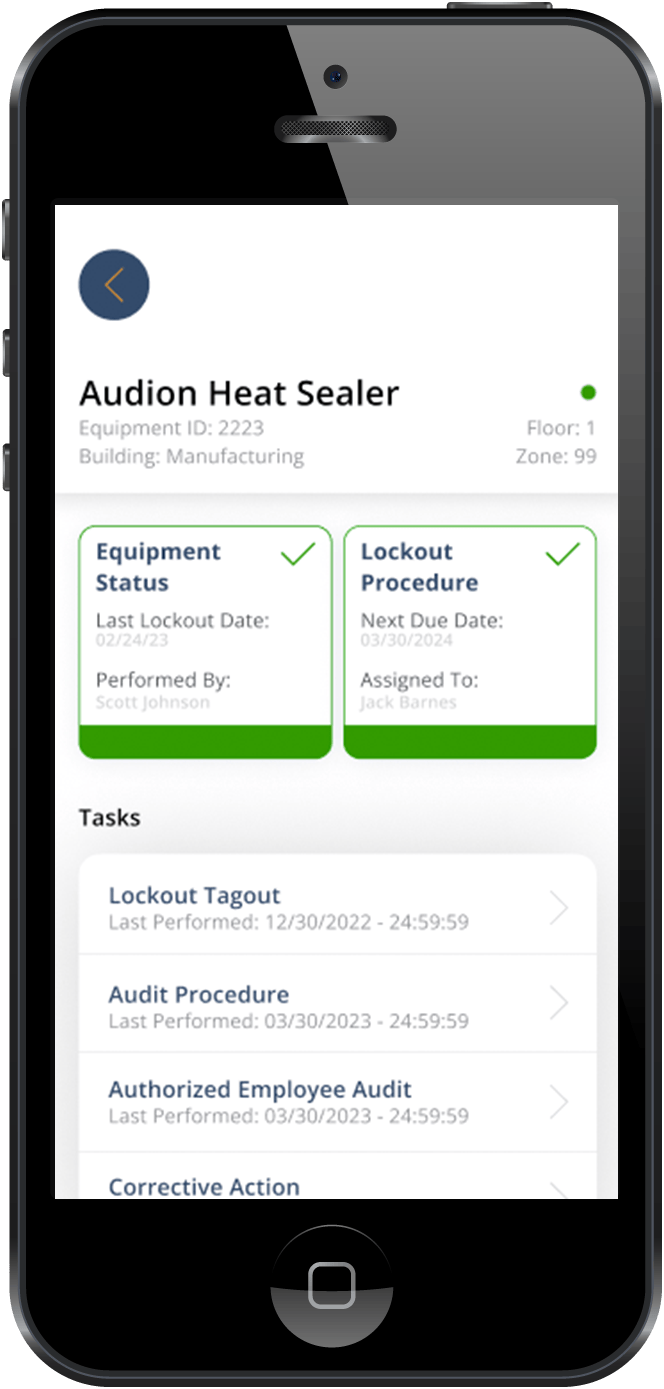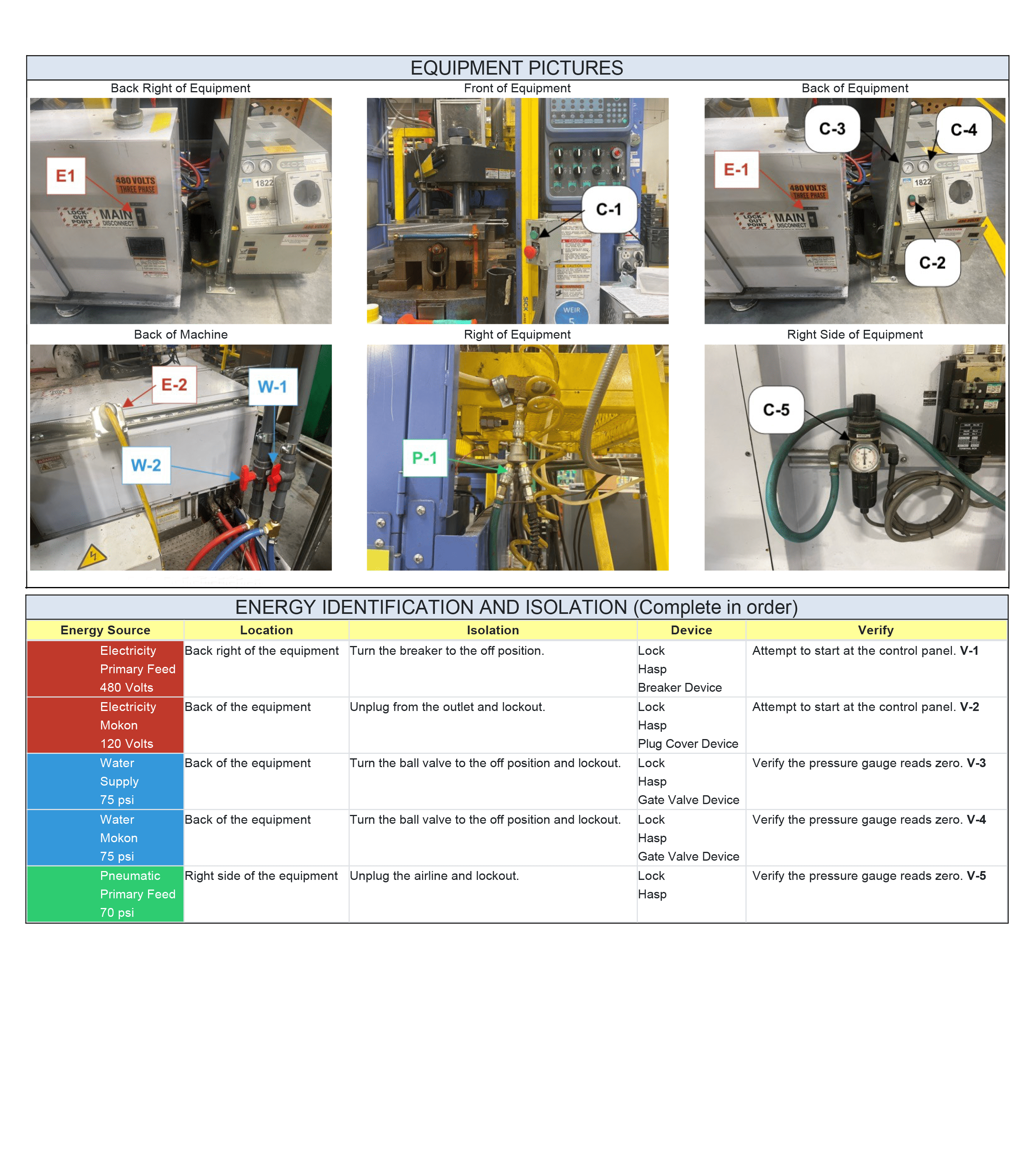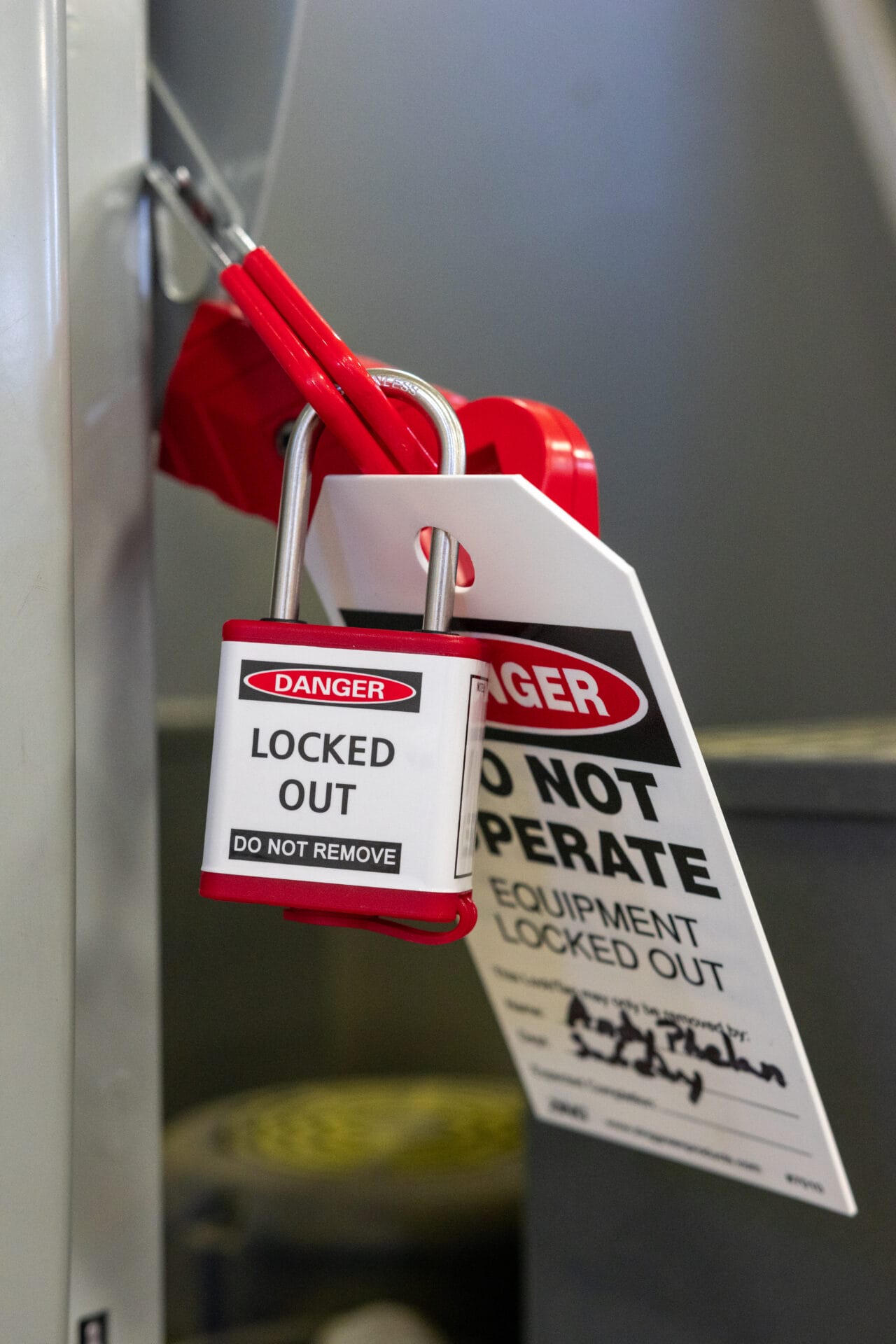Let’s explore the basics of lockout tagout devices: what they are, how they are used, and why they are important.

Lockout Tagout Devices – A Lock and Tag on a Machine
What Are Lockout Tagout Devices?
As defined by the Occupational Safety and Health Administration (OSHA), a lockout device is
“Lockout Device: Any device that uses positive means, such as a lock, blank flanges and bolted slip blinds, to hold an energy-isolating device in a safe position, thereby preventing the energizing of machinery or equipment”
and a tagout device is
“Tagout Device: Any prominent warning device, such as a tag and a means of attachment, that can be securely fastened to an energy-isolating device to indicate that the machine or equipment to which it is attached may not be operated until the tagout device is removed”.
Since these tools (locks and tags) tend to be used in conjunction for lockout tagout procedures, they are generally referred to as “lockout tagout devices”. However, locks and tags are not the only lockout tagout devices available. There are many forms of specialized equipment on the market that can be used for hazardous energy control.
Here is a list of lockout tagout devices to be familiar with:
- Lockout Cables with Hasps & Locks
- Lockout Padlocks
- Circuit Breaker Lockouts
- Cable Lockouts
- Group Lockout Tagout Boxes
- Lockout Tagout Kits
- Lockout Tagout Stations
- Lockout Tags
- Plug/Gate/Ball Valve Devices
- Lockout/Tagout Signs & Posters
- Lockouts for Electrical Equipment
Depending on the volume and forms of machinery at a workplace, companies may own many if not all of these kinds of loto devices. Because of this, familiarity with various types of equipment will allow workers to approach a wide range of lockout tagout procedures with confidence.
The Purpose of Lockout Tagout Devices
The purpose of lockout tagout devices is to aid in the process of performing lockout tagout procedures. Lockout tagout is a legally-mandated safety measure that is meant to protect workers during the servicing and maintenance of machines/equipment in which the unexpected energization or start up of the machines/equipment, or release of stored energy, could injure them or others.
In this process, lockout tagout devices play 2 essential roles. They are responsible for providing 1. proper securement of a shutdownand de-energized machine and 2. readily visible information regarding the state of the machinery and associated danger.
What Devices Are Used For Lockout Vs. Tagout?
There are 2 main functions of lockout tagout devices. Some are used to prevent accidental machine startup/energy release (lockout) and others are used to convey vital information to anyone near the machinery or equipment that is being worked on (tagout). Because of these contrasting roles, different lockout tagout devices are used for different activities. However, all devices used during lockout tagout activities are meant to promote safety, reduce risk, and safeguard lives and property.
Devices Used for Lockout:
The primary form of equipment that is used to lockout machinery is padlocks. During the lockout portion of the process, an authorized employee prepares the machine for shut down. To do this, they inform other affected employees of the upcoming shut down and then turn off the equipment. Once the machine is completely shut down, the energy sources are isolated and the lock can be applied. Locks used in lockout tagout help to secure the energy sources, keeping them fully off until the machine is ready to be restored to full functionality.
Devices Used For Tagout:
The primary form of equipment that is used to tagout machinery is plastic, waterproof tags that detail the current state of the equipment. Once a piece of equipment has been properly shut down and locked out, a tag is attached to the machine to provide key information to any workers nearby. The tag details who locked out the equipment, when they did so, and the level of danger or caution that is needed.
Other Devices:
While locks and tags are the main forms of equipment used to complete lockout tagout procedures, other devices may be used for group loto, storage, or specific machinery.
OSHA Requirements of Lockout Tagout Devices
The 3 main requirements from OSHA regarding lockout tagout devices are that they must be durable, substantial, and identifiable. These are outlined in standard 29 CFR 1910.147 and provide a framework for the quality and characteristics of loto devices.
Durable
- According to OSHA standard 29 CFR 1910.147(c)(5)(ii), LOTO devices must be:
- Durable enough to withstand the environment in which they are used.
- Constructed of materials that can endure exposure to moisture, chemicals, and other harsh conditions.
- Tags should not deteriorate when used in corrosive environments (ex. areas where acid and alkali chemicals are handled and stored).
- Standardized in at least one way (color, shape, or size). For tags there should also be standardization of the print and format.
Substantial
- The standard further explains requirements regarding substantiality. These include that lockout tagout devices should:
- Be substantial enough to prevent inadvertent or accidental removal.
- Loto device attachment means are required to be a non-reusable type, attachable by hand, self-locking, and non-releasable with a minimum unlocking strength of no less than 50 pounds.
- Attachments for tags should be at least equivalent in design and function to a piece of all-environment-tolerant nylon cable tie.
Identifiable
- The standard also makes a point to highlight requirements for making lockout tagout devices identifiable. In order to accomplish this, they must:
- indicate the identity of the worker who applied the device(s)
- use clear wording to warn against hazardous conditions such as Do Not Start, Do Not Open, Do Not Close, Do Not Energize, Do Not Operate.
Along with these 3 main points, OSHA also mandates that a colored LOTO tag system be standardized and used exclusively for safety. This means that there needs to be consistency in the usage and application of each color of tag as well as limited LOTO tag use (only for actions related to lockout tagout procedures). To learn more about OSHA’s recommended coloring system, see our article here.
What Are the Most Common Types of LOTO Devices?
The top 3 most frequently used lockout tagout devices include padlocks, safety hasps, and tags.
- Padlocks come in various shapes and sizes and should have only 1 working key. That way, only the authorized personnel who attached it can remove the device.
- Safety hasps are utilized for group lockouts where multiple padlocks are used for one energy source. They should be incorporated into the process anytime more than one person is participating in the lockout tagout.
- Tags that are often fastened on padlocks to inform other workers that maintenance is ongoing.

Most Common Lockout Tagout Devices (1)
The Steps of Lockout Tagout Device Usage
There are 10 essential steps to completing lockout tagout procedures. These steps can help provide a guideline for when to attach and remove lockout tagout devices.
Before Attaching Lockout tagout Devices:
- Prep for Shutdown (and notify affected employees)
- Equipment Shutdown
- Isolation of Energy Sources
Application of Devices:
- Lockout Tagout Device Application
- Dissipation of Residual or Stored Energy
- Verification of Isolation
- Performing Maintenance or Servicing
Removal of LOTO Devices:
- Release from Lockout Tagout
- Equipment Restart
- Documentation and Recordkeeping
These steps highlight how there are essential actions that must be taken both before a lockout tagout device is attached and before it is removed. Following this sequence will ensure that equipment is used properly, thereby increasing safety.
Who Can Remove a Lockout Tagout Device?
The authorized employee who placed the lock and tag on the de-energized equipment should be the only one who removes it. This is a safety measure that promotes effective communication and helps ensure that there aren’t any accidents or injuries from miscommunication.
What to do if the employee who applied the lock/tag is unable to remove it:
Various circumstances such as a procedure taking much longer than expected or a shift change can result in an authorized employee not being present to remove the loto devices they attached to machinery. In the event that the authorized employee who applied the lockout/tagout device is unable to remove it, other workers should turn to direction from their manager or employer. The manager or employer can verify that correct procedures are followed and adequate communication is given so that other trained personnel can assist in removing the loto device(s).
Before taking any action, employers should do these 3 things:
- Ensure that the employee who applied the lock/tag is no longer at the facility
- Make a reasonable effort to notify the employee that their lock/tag is being removed by someone else
- Verify that the employee knows and understands that their device has been removed
For more guidance on this matter, see OSHA’s statements in 29 CFR 1910.147 (e)(3).
Storing Lockout Tagout Devices
It is common practice among industries and workplaces that use lockout tagout to have loto kits or a station for organizing and storing devices. This is in part due to the fact that items such as padlocks are only supposed to have one working key for their usage. With only a singular key and padlock that go together, it is important to keep tabs on their location. Having a designated place for storing and obtaining loto equipment can reduce the risk of losing valuable items.
Lockout Tagout Equipment Stations
Lockout tagout stations can provide a central place for storing and organizing equipment, making them an ideal option for companies with multiple sets of devices. Particularly if there are a number of individuals trained to perform lockout tagout, this setup can eliminate confusion about whose equipment is whose. Additionally, LOTO stations (generally yellow or red in color) come in a variety of sizes and shapes. There are options for cabinets, wall mounted stations, or even portable boxes. These options allow companies of all different sizes and needs to find something that works for them.
Lockout Tagout Kits
Lockout tagout kits provide a way for companies to organize equipment that is needed for particular machinery or equipment. This can be especially helpful for things such as electrical work or machinery that needs special valve covers. Having pre-made kits can reduce the time needed to gather materials and perform routine lockout tagout procedures. Often, these kits can be bought already organized (or assembled by the team) and come in boxes with handles for easy transportation.
Conclusion
Lockout tagout devices are great tools for completing loto procedures. They provide valuable assistance in maintaining safety during the servicing or maintenance activities on hazardous energy sources. In order to get the most value from using lockout tagout devices, it helps to understand their purpose, requirements, steps for usage, storage, and more. By understanding the fundamentals of these tools, workers can maximize safety in their workplace and more effectively conduct lockout tagout.







